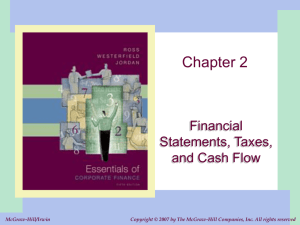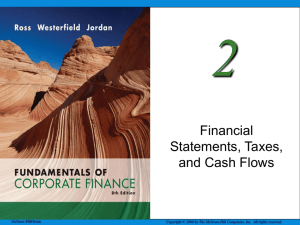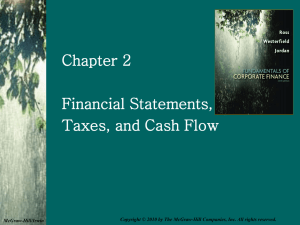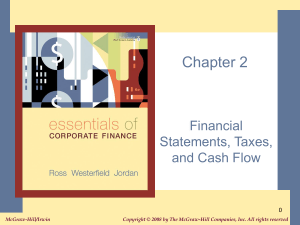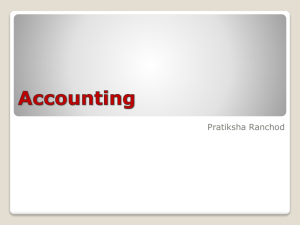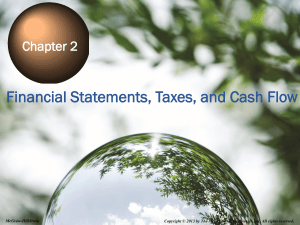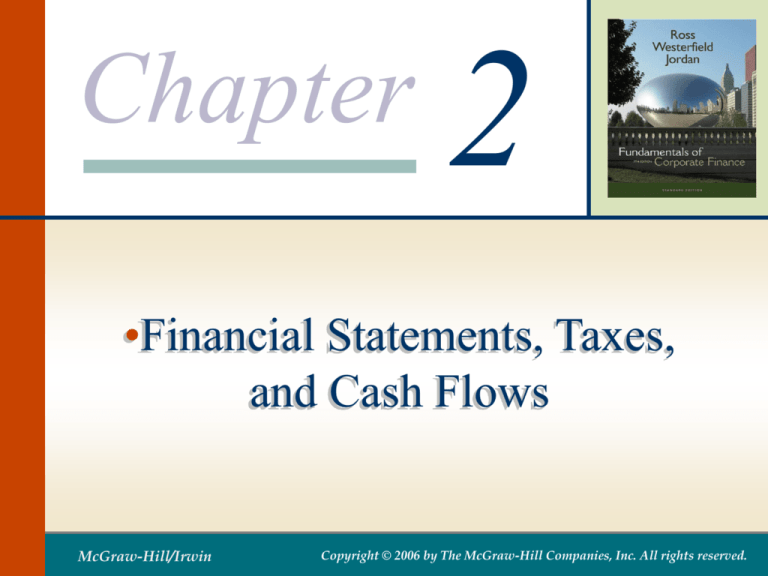
Chapter
2
•Financial Statements, Taxes,
and Cash Flows
McGraw-Hill/Irwin
Copyright © 2006 by The McGraw-Hill Companies, Inc. All rights reserved.
Key Concepts and Skills
• Know the difference between book value
and market value
• Know the difference between accounting
income and cash flow
• Know the difference between average and
marginal tax rates
• Know how to determine a firm’s cash flow
from its financial statements
2-1
Chapter Outline
•
•
•
•
The Balance Sheet
The Income Statement
Taxes
Cash Flow
2-2
Balance Sheet資產負債表
• The balance sheet is a snapshot of the
firm’s assets and liabilities at a given point
in time
• Assets are listed in order of liquidity流動性
• Ease of conversion to cash
• Without significant loss of value
• Balance Sheet Identity
• Assets = Liabilities + Stockholders’ Equity
2-3
• Liquidity is a very important concept.
• Students tend to remember the “convert to cash
quickly” component of liquidity, but often forget
the part about “without loss of value.”
• Remind them that we can convert anything to
cash quickly if we are willing to lower the price
enough, but that doesn’t mean it is liquid.
• Also, point out that a firm can be TOO liquid.
Excess cash holdings lead to overall lower
returns.
2-4
The Balance Sheet - Figure 2.1
2-5
Net Working Capital and
Liquidity
• Net Working Capital淨營運資金
• Current Assets – Current Liabilities流動資產-流動負債
• Positive when the cash that will be received over the next 12
months exceeds the cash that will be paid out
• Usually positive in a healthy firm
• Liquidity流動性
•
•
•
•
Ability to convert to cash quickly without a significant loss in value
Liquid firms are less likely to experience financial distress
But liquid assets earn a lower return
Trade-off to find balance between liquid and illiquid assets
2-6
US Corporation Balance Sheet –
Table 2.1
2-7
Market Vs. Book Value
• The balance sheet provides the book value
帳面價值of the assets, liabilities and equity.
• Market value is the price at which the
assets, liabilities or equity can actually be
bought or sold.
• Market value and book value are often very
different. Why?
• Which is more important to the decisionmaking process?
2-8
• Current assets and liabilities generally have book
values and market values that are very close.
• Assets are listed at historical costs less
accumulated depreciation – this may bear little
resemblance to what they could actually be sold
for today
• The balance sheet also does not include the
value of many important assets, such as human
capital.
• Consequently, the “Total Assets” line on the
balance sheet is generally not a very good
estimate of what the assets of the firm are
actually worth
2-9
• Liabilities are listed at face value. When
interest rates change or the risk of the firm
changes, the value of those liabilities
change in the market as well. This is
especially true for longer-term liabilities.
2-10
• Equity is the ownership interest in the firm.
• The market value of equity (stock price
times number of shares) depends on the
future growth prospects of the firm and on
the market’s estimation of the current
value of ALL of the assets of the firm.
2-11
• The best estimate of the market value of
the firm’s assets is market value of
liabilities + market value of equity.
• Market values are generally more
important for the decision making process
because they are more reflective of the
cash flows that would occur today.
2-12
Example 2.2 Klingon
Corporation
NWC
NFA
KLINGON CORPORATION
Balance Sheets
Market Value versus Book Value
Book Market
Book Market
Assets
Liabilities and
Shareholders’ Equity
$ 400 $ 600 LTD
$ 500 $ 500
700 1,000 SE
600 1,100
1,100 1,600
1,100 1,600
2-13
• Shareholders are the ones that benefit
from increases in the market value of a
firm’s assets.
• They are also the ones that bear the losses
of a decrease in market value.
• Consequently, managers need to consider
the impact of their decisions on the market
value of assets, not on their book value.
2-14
• Suppose that the MV of assets declined to
$700 and the market value of long-term
debt remained unchanged.
• What would happen to the market value of
equity? It would decrease to 700 – 500 =
200.
2-15
• The market-to-book ratio, which compares the
market value of equity to the book value of equity,
is often used by analysts as a measure of
valuation for a stock.
• It is generally a bad sign if a company’s marketto-book ratio approaches 1.00 (meaning market
value = book value) because of the GAAP
employed in creating a balance sheet.
• It is definitely a bad sign if the ratio is less than
1.00.
2-16
• GAAP does provide for some assets to be
marked-to-market, primarily those assets
for which current market values are readily
available due to trading in liquid markets
• However, it does not generally apply to
long-term assets, where market values and
book values are likely to differ the most
2-17
Income Statement損益表
• The income statement is more like a video of the
firm’s operations for a specified period of time.
• You generally report revenues first and then
deduct any expenses for the period
• Matching principle配合原則– GAAP say to show
revenue when it accrues and match the
expenses required to generate the revenue
• this principle leads to non-cash deductions like
depreciation.
• This is why net income is NOT a measure of the cash
flow during the period.
2-18
US Corporation Income Statement –
Table 2.2
2-19
Work the Web Example
• Publicly traded companies must file regular
reports with the Securities and Exchange
Commission定期申報財務報表
• These reports are usually filed
electronically and can be searched at the
SEC public site called EDGAR
• Click on the web surfer, pick a company
and see what you can find!
2-20
Taxes
• The one thing we can rely on with taxes is
that they are always changing
• Marginal vs. average tax rates
• Marginal – the percentage paid on the next
dollar earned
• Average – the tax bill / taxable income
• Other taxes
2-21
Example: Marginal Vs. Average
Rates
• Suppose your firm earns $4 million in
taxable income.
• What is the firm’s tax liability?
• What is the average tax rate?
• What is the marginal tax rate?
• If you are considering a project that will
increase the firm’s taxable income by $1
million, what tax rate should you use in
your analysis?
2-22
• Tax liability:
• .15(50,000) + .25(75,000 – 50,000)
+ .34(100,000 – 75,000) + .39(335,000 –
100,000) + .34(4,000,000 – 335,000) =
$1,356,100
• Average rate: 1,356,100 / 4,000,000
= .339025 or 33.9025%
• Marginal rate comes from the table and it is
34%
2-23
• Should use the marginal rate with an
expected additional 34,000 in taxes and a
change in the average rate to 1,390,100 /
4,000,000 = .347525 or 34.7525%
2-24
The Concept of Cash Flow
• Cash flow is one of the most important
pieces of information that a financial
manager can derive from financial
statements
• The statement of cash flows does not
provide us with the same information that
we are looking at here
• We will look at how cash is generated from
utilizing assets and how it is paid to those
that finance the purchase of the assets
2-25
Cash Flow From Assets
• Cash Flow From Assets (CFFA) = Cash
Flow to Creditors + Cash Flow to
Stockholders
• How the cash flow from the firm is divided
among the investors that financed the assets
• Cash Flow From Assets = Operating Cash
Flow – Net Capital Spending – Changes in
NWC
2-26
• The second equation is the cash flow that
the firm receives from its assets.
• This is an important equation to remember.
• We will come back to it and use it again
when we do our capital budgeting analysis.
• We want to base our decisions on the
timing and risk of the cash flows we expect
to receive from a project.
2-27
Example: US Corporation – Part I
• OCF (I/S) = EBIT + depreciation – taxes =
$547
• OCF = 694 + 65 – 212 = 547
• NCS ( B/S and I/S) = ending net fixed
assets – beginning net fixed assets +
depreciation = $130
• NCS = 1709 – 1644 + 65 = 130
2-28
• Changes in NWC ( B/S ) = ending NWC –
beginning NWC = $330
• Ending NWC = 1403 – 389 = 1014
• Beginning NWC = 1112 – 428 = 684
• Changes in NWC = 1014 – 684 = 330
• CFFA = 547 – 130 – 330 = $87
2-29
Example: US Corporation – Part II
• CF to Creditors ( B/S and I/S) = interest
paid – net new borrowing = $24
• Net New Borrowing = ending LT debt – beginning
LT debt = 454 – 408 = 46
• CF to creditors = 70 – 46 = 24
• CF to Stockholders ( B/S and I/S) = dividends
paid – net new equity raised = $63
• Net New Equity = 640 – 600 = 40
• CF to Stockholders = 103 – 40 = 63
• CFFA = 24 + 63 = $87
2-30
Cash Flow Summary Table 2.5
2-31
Quick Quiz
• What is the difference between book value
and market value? Which should we use for
decision making purposes?
• What is the difference between accounting
income and cash flow? Which do we need to
use when making decisions?
• What is the difference between average and
marginal tax rates? Which should we use
when making financial decisions?
• How do we determine a firm’s cash flows?
What are the equations and where do we find
the information?
2-32
Chapter
2
•End of Chapter
McGraw-Hill/Irwin
Copyright © 2006 by The McGraw-Hill Companies, Inc. All rights reserved.


